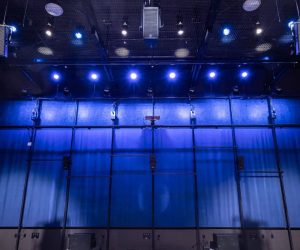
Meyer Sound Constellation Provides Surgical AV for Sweden’s Leading Medical School
Consistently ranked among the world’s leading medical schools, Sweden’s Karolinska Institute recently expanded its Stockholm-area campus with construction of the KI-NEO building. The new facility brings the latest in 21st century learning technologies to the 200-year-old institution, including Meyer Sound Constellation acoustic systems in two principal lecture and conference rooms.
“In an era when technology leads to so much detached and impersonal communication, making a direct connection between a speaker and listeners in the same room is more important than ever,” says Anders Jørgensen, project leader for Stouenborg ApS, the Danish AV consulting and integration firm. “With Meyer Sound Constellation we can enhance interpersonal communication by effectively making a large lecture hall work acoustically like a more intimate classroom. In a lecture hall where the distance between professor and student might be 30 or 40 meters, Constellation can shrink that space dramatically to allow effortless, two-way communication without using either fixed or radio microphones. This is making a significant difference at Karolinska Institute.”
In the early design phases of the KI-NEO building, the potential benefits of employing active acoustic systems for voice lifting were presented by the acoustical consulting firm of AVR – AV Raadgiverne. Subsequently, a team from the Karolinska Institute visited the San Francisco Bay Area for demonstrations at Meyer Sound’s Berkeley headquarters and in a new Constellation-equipped classroom at Stanford University.
After the contract was awarded, Stouenborg embarked on a 30-month process, first working with the Meyer Sound Constellation team on system design, pre-wiring all equipment racks in Denmark, and finally moving on-site to install more than 400 loudspeakers and 250 microphones using more than 25 km of cabling. The Stouenborg team worked closely with the general contractor for the project, Veidekke Sverige AB.
“What makes Constellation uniquely fitted to a learning environment is its power to enhance speech,” continues Jørgensen. “The loudspeakers and microphones are unobtrusive and allow the lecturer to be heard clearly from anywhere in the auditorium without the hassle of personal microphones. The same technology allows students to freely ask questions of the professor, and of each other, and still be heard clearly in a 400-seat hall.”
The Constellation system in the Round Room of the new KI-NEO building comprises a total of 130 MM-4XP self-powered miniature loudspeakers and 12 MM-10XP miniature subwoofers. A distributed array of 53 miniature cardioid and eight shotgun microphones pick up sounds in the space for processing by a 22-module D-Mitri digital audio platform, with four modules hosting the patented VRAS variable room acoustic system algorithm.
Installation and calibration in the MPR room was even more complex, as this space can be subdivided into two, three or four separate spaces, each with its own acoustical characteristics. The total count of MM-4XP loudspeakers here is 212, augmented by 12 MM-10XP subwoofers. The 68 miniature cardioid microphones feed a complement of D-Mitri digital processing modules essentially identical to that of the Round Room.
Each room also includes a direct reinforcement system, used primarily for recorded and external sources. The Round Room system is a pair of HMS-12 loudspeakers, and six UPJ-1P loudspeakers are employed in the MPR Room.
Peter Allstram, who served as project leader on behalf of the Karolinska Institute, notes that the key point for the school was to foster greater dialogue between professors and students in the lecture hall setting.
“To engage in true dialogue in a big hall, we need an audio system that can promote back-and-forth communication without getting in the way,” Allstram remarks. “In most halls we looked at around the world, both the lecturer and student audience have to rely on loose microphones. But often the listeners did not want to bother with the microphones yet tried to speak anyway, with the consequence that many could not understand the questions.”
“With Constellation, the acoustics are controlled and can be adapted to whatever activity is happening in the room. You can speak normally wherever you are in the room, and the sound from others who are talking originates naturally from where they are located, not as amplified sound from a loudspeaker at some other location.”
Stouenborg has completed several other high-profile installations of Constellation systems for voice lifting, most notably at Jyske Bank in Sikeborg, Denmark and the new Maersk Tower of Panum Institute’s Faculty of Health and Medical Sciences at the University of Copenhagen.
Meyer Sound: meyersound.com
Australian Distributor: www.audiobrands.com.au















RESPONSES